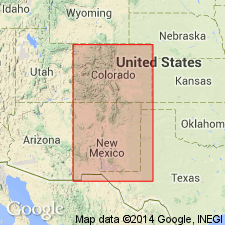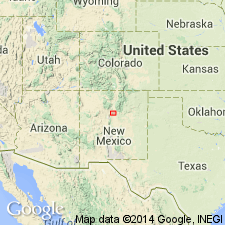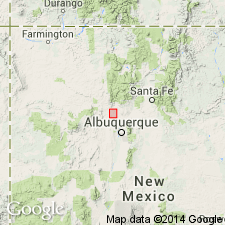
- Usage in publication:
-
- Gallisteo sand group*
- Modifications:
-
- First used
- Dominant lithology:
-
- Sandstone
- Limestone
- AAPG geologic province:
-
- Estancia basin
Summary:
Probably named for Gallisteo Creek, Santa Fe Co, NM in the Estancia basin. Consists of variegated sands, sandstones, and calcareous sandstones. Varies in texture from fine quartz particles to puddingstone. Some irregular, brown, concretionary, arenaceous limestone. Contains an abundance of petrified wood. Overlies Placer Mountain beds (new). Also called Gallisteo sands (p. 90). Thought to be middle Tertiary age.
Source: GNU records (USGS DDS-6; Denver GNULEX).

- Usage in publication:
-
- Galisteo formation
- Modifications:
-
- Redescribed
- Dominant lithology:
-
- Clay
- Sand
- Sandstone
- Conglomerate
- Limestone
- Tuff
- AAPG geologic province:
-
- Many basins
Summary:
Galisteo redescribed as a formation in Galisteo-Tongue area of north-central NM, Sandoval and Santa Fe Cos, San Juan and Estancia basins. Consists of fluviatile deposits, including medium- to coarse-grained, gray-white or buff, yellow, red, brown, or pink sandstone and sand, with abundant silicified wood (this is the characteristic rock type of the unit); lenticular pebbly sandstone and conglomerate (the conglomerate together with the sandstone and sand comprises about two-thirds of the unit); variegated, unindurated clay; 2-3 ft beds of fresh-water limestone, present in some localities; and water-laid tuff, present in a few localities, mostly in the upper hundred ft. Deposited by rivers in a broad, deep inland basin. Varies in thickness from 900 to at least 4,300 ft, increasing to southeast, where it may have been between 5,000 and 6,000 ft thick. Unconformably overlies Upper Cretaceous rocks, including Mesaverde formation and Mancos shale. Underlies Espinaso volcanics (new) conformably, with transitional contact; deposition of Espinaso followed deposition of Galisteo without a break. Galisteo is of Duchesnean (late Eocene or early Oligocene) age based on vertebrate fossil evidence collected from the upper few hundred ft, including TELEODUS sp. and UINTACYON sp. Lower portion may include beds older than Duchesnean. Measured sections, isopach map, geologic map.
Source: GNU records (USGS DDS-6; Denver GNULEX).

- Usage in publication:
-
- Galisteo Formation
- Modifications:
-
- Revised
- AAPG geologic province:
-
- San Juan basin
Summary:
Galisteo Formation revised--upper contact changed. Now overlain unconformably by Piedra Parada Member of Zia Sand Formation (both new, this report) in Jemez Creek area, Sandoval Co, NM in San Juan basin. A laminated greenish clay deposit lies about 30 ft thick beneath the unconformity at base of Zia Sand Formation at its type section, and Piedra Parada Member (type section of Piedra Parada is lower 400 ft of Zia section); the deposit in turn conformably overlies Galisteo deposits. This deposit is here tentatively regarded as part of Galisteo.
Source: GNU records (USGS DDS-6; Denver GNULEX).
For more information, please contact Nancy Stamm, Geologic Names Committee Secretary.
Asterisk (*) indicates published by U.S. Geological Survey authors.
"No current usage" (†) implies that a name has been abandoned or has fallen into disuse. Former usage and, if known, replacement name given in parentheses ( ).
Slash (/) indicates name conflicts with nomenclatural guidelines (CSN, 1933; ACSN, 1961, 1970; NACSN, 1983, 2005, 2021). May be explained within brackets ([ ]).

